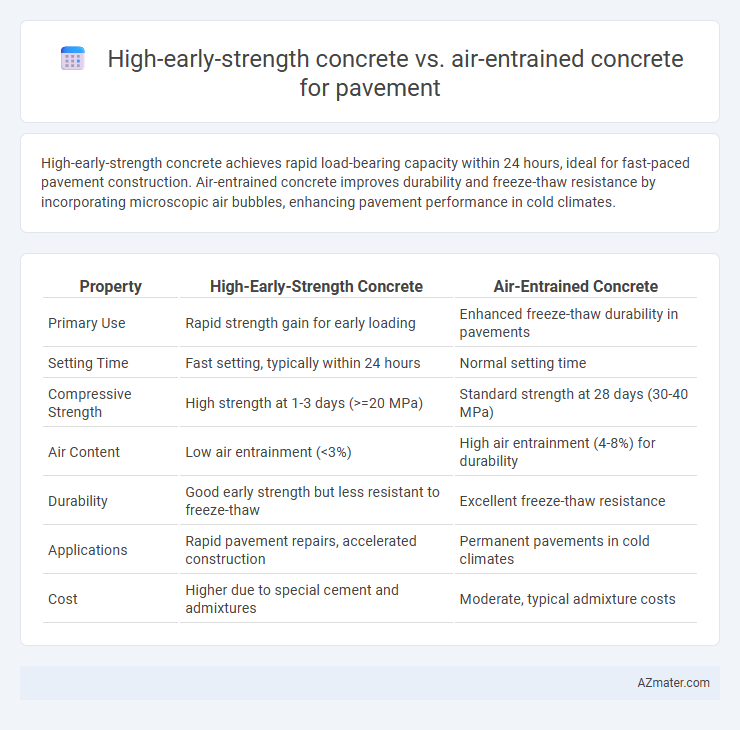High-early-strength concrete achieves rapid load-bearing capacity within 24 hours, ideal for fast-paced pavement construction. Air-entrained concrete improves durability and freeze-thaw resistance by incorporating microscopic air bubbles, enhancing pavement performance in cold climates.
Table of Comparison
| Property | High-Early-Strength Concrete | Air-Entrained Concrete |
|---|---|---|
| Primary Use | Rapid strength gain for early loading | Enhanced freeze-thaw durability in pavements |
| Setting Time | Fast setting, typically within 24 hours | Normal setting time |
| Compressive Strength | High strength at 1-3 days (>=20 MPa) | Standard strength at 28 days (30-40 MPa) |
| Air Content | Low air entrainment (<3%) | High air entrainment (4-8%) for durability |
| Durability | Good early strength but less resistant to freeze-thaw | Excellent freeze-thaw resistance |
| Applications | Rapid pavement repairs, accelerated construction | Permanent pavements in cold climates |
| Cost | Higher due to special cement and admixtures | Moderate, typical admixture costs |
Introduction to Specialized Pavement Concretes
High-early-strength concrete accelerates the curing process, enabling rapid load application and minimizing traffic disruptions in pavement construction. Air-entrained concrete improves freeze-thaw durability through microscopic air bubbles, enhancing pavement longevity in cold climates. Selecting between these specialized concretes depends on project timelines and environmental exposure to optimize pavement performance.
Defining High-Early-Strength Concrete
High-early-strength concrete is formulated to achieve rapid strength gain within 24 to 48 hours, enabling faster construction and reopening of pavements to traffic. It typically incorporates higher cement content, special admixtures, and supplementary cementitious materials like silica fume or fly ash to accelerate the hydration process. In contrast, air-entrained concrete contains microscopic air bubbles that improve freeze-thaw durability by reducing internal pressure from water expansion, making it essential for pavements subjected to cyclic freezing conditions.
Understanding Air-Entrained Concrete
Air-entrained concrete enhances pavement durability by incorporating microscopic air bubbles, which improve resistance to freeze-thaw cycles and reduce scaling caused by de-icing salts. This type of concrete is particularly effective in cold climates where moisture expansion within the pavement can lead to cracking and surface deterioration. Unlike high-early-strength concrete, which gains rapid strength for quicker construction, air-entrained concrete prioritizes long-term resilience and resistance to environmental stressors.
Key Differences in Composition
High-early-strength concrete for pavement incorporates higher cement content and specialized admixtures like calcium chloride or other accelerators to achieve rapid strength gain, while air-entrained concrete contains microscopic air bubbles introduced through air-entraining agents to improve freeze-thaw durability. The primary difference in composition is the focus on cement chemistry and admixture type, with high-early-strength concrete emphasizing rapid hydration and early load-bearing capacity, and air-entrained concrete prioritizing resistance to damage from cyclic freezing and thawing by providing internal air voids. These compositional distinctions directly impact the respective performance characteristics essential for specific pavement environments and application timelines.
Performance in Freeze-Thaw Environments
High-early-strength concrete offers rapid strength gain but typically lacks the freeze-thaw durability provided by air-entrained concrete, which incorporates tiny air bubbles to resist cracking from ice formation. Air-entrained concrete significantly improves pavement performance in freeze-thaw environments by enhancing resistance to scaling and surface deterioration caused by cyclic freezing and thawing. Studies show that pavements constructed with air-entrained concrete maintain structural integrity and skid resistance better over time in harsh climates compared to those with high-early-strength concrete without air entrainment.
Strength Development and Curing Times
High-early-strength concrete achieves rapid strength development, reaching up to 4000 psi within 24 hours, significantly reducing curing times and allowing faster pavement opening to traffic. Air-entrained concrete enhances freeze-thaw durability by incorporating microscopic air bubbles but typically develops strength more slowly, often requiring 7 to 28 days of curing to reach optimal performance. Selecting between these concretes depends on project priorities, balancing the need for quick strength gain against the long-term durability benefits of air entrainment in pavement applications.
Workability and Placement Considerations
High-early-strength concrete offers rapid strength gain, which reduces curing time and enables quicker pavement opening, but it typically requires careful mixing and placing to avoid premature stiffening and ensure uniform workability. Air-entrained concrete improves freeze-thaw durability through microscopic air bubbles, enhancing workability by increasing the mix's plasticity and resistance to segregation, but requires precise air content control for optimal placement performance. Both types demand adapted handling techniques: high-early-strength concrete often benefits from temperature-controlled conditions to maintain workability, while air-entrained concrete needs consistent air entrainment throughout batching and placing to meet pavement durability standards.
Durability and Longevity Factors
High-early-strength concrete achieves rapid strength gain through accelerated hydration, which enhances early load-bearing capacity but may increase susceptibility to thermal cracking and shrinkage, potentially affecting long-term durability. Air-entrained concrete incorporates microscopic air bubbles that improve freeze-thaw resistance and reduce internal stress from moisture expansion, significantly extending pavement longevity in cold climates. Evaluating durability factors reveals that while high-early-strength concrete benefits rapid construction schedules, air-entrained concrete is superior for mitigating environmental degradation and ensuring pavement lifespan.
Cost Implications for Pavement Projects
High-early-strength concrete accelerates pavement construction by reducing curing time, leading to lower labor and equipment rental costs, but its material cost is generally higher than standard mixes. Air-entrained concrete, while slightly more expensive due to the admixtures, offers enhanced durability and freeze-thaw resistance, reducing long-term maintenance expenses. Choosing between the two depends on balancing initial material investment against lifecycle cost savings and project timeline priorities.
Choosing the Right Concrete for Pavement Applications
High-early-strength concrete accelerates construction schedules by achieving rapid strength gain, making it ideal for fast-track pavement projects requiring early load application. Air-entrained concrete enhances durability and resistance to freeze-thaw cycles by incorporating microscopic air bubbles, which is critical for pavements exposed to harsh weather conditions. Selecting the right concrete depends on the project's timeline, environmental exposure, and long-term performance requirements to ensure pavement longevity and safety.

Infographic: High-early-strength concrete vs Air-entrained concrete for Pavement
 azmater.com
azmater.com